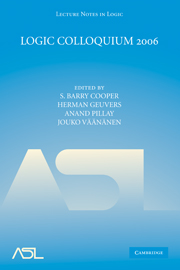Book contents
- Frontmatter
- Contents
- Introduction
- Definability and elementary equivalence in the Ershov difference hierarchy
- A unified approach to algebraic set theory
- Brief introduction to unprovability
- Higher-order abstract syntax in type theory
- An introduction to b-minimality
- The sixth lecture on algorithmic randomness
- The inevitability of logical strength: Strict reverse mathematics
- Applications of logic in algebra: Examples from clone theory
- On finite imaginaries
- Strong minimal covers and a question of Yates: The story so far
- Embeddings into the Turing degrees
- Randomness—beyond Lebesgue measure
- The derived model theorem
- Forcing axioms and cardinal arithmetic
- Hrushovski's amalgamation construction
Applications of logic in algebra: Examples from clone theory
Published online by Cambridge University Press: 28 January 2010
- Frontmatter
- Contents
- Introduction
- Definability and elementary equivalence in the Ershov difference hierarchy
- A unified approach to algebraic set theory
- Brief introduction to unprovability
- Higher-order abstract syntax in type theory
- An introduction to b-minimality
- The sixth lecture on algorithmic randomness
- The inevitability of logical strength: Strict reverse mathematics
- Applications of logic in algebra: Examples from clone theory
- On finite imaginaries
- Strong minimal covers and a question of Yates: The story so far
- Embeddings into the Turing degrees
- Randomness—beyond Lebesgue measure
- The derived model theorem
- Forcing axioms and cardinal arithmetic
- Hrushovski's amalgamation construction
Summary
In this article, an “algebra” (sometimes also called a “universal algebra”) is a nonempty set X together with a set of “basic operations”; each operation is a finitary total function on X, i.e., a function ƒ : Xn → X for some n ∈ {1, 2, …}. While our operations always have finite arity, we allow infinitely many basic operations in our algebras.
Clone theory investigates the structure of all algebras on a given set. It turns out that several questions originating in algebra can be solved (or at least attacked) with set-theoretic methods. This article collects a few examples of this approach, based on recent results of Pinsker, Shelah and the author.
Background. A large part of universal algebra investigates the relations between the basic operations of an algebra; here we take a different point of view—all term operations are considered to live an an equal level; thus we will, for example, not distinguish between a Boolean algebra and the corresponding Boolean ring, because each ring operation can be written as composition of operations of the Boolean algebra, and conversely.
This point of view is motivated by the observation that many properties of algebras depend only on the clone of its term functions or polynomials, without any need to distinguish basic operations; for example, an equivalence relation is a congruence relation iff it is closed under all unary polynomials.
- Type
- Chapter
- Information
- Logic Colloquium 2006 , pp. 184 - 194Publisher: Cambridge University PressPrint publication year: 2009

